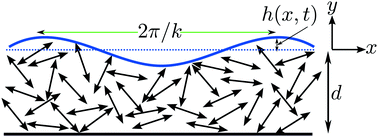Stability of the interface of an isotropic active fluid
Abstract
We study the linear stability of an isotropic active fluid in three different geometries: a film of active fluid on a rigid substrate, a cylindrical thread of fluid, and a spherical fluid droplet. The active fluid is modeled by the hydrodynamic theory of an active nematic liquid crystal in the isotropic phase. In each geometry, we calculate the growth rate of sinusoidal modes of deformation of the interface. There are two distinct branches of growth rates; at long wavelength, one corresponds to the deformation of the interface, and one corresponds to the evolution of the liquid crystalline degrees of freedom. The passive cases of the film and the spherical droplet are always stable. For these geometries, a sufficiently large activity leads to instability. Activity also leads to propagating damped or growing modes. The passive cylindrical thread is unstable for perturbations with wavelength longer than the circumference. A sufficiently large activity can make any wavelength unstable, and again leads to propagating damped or growing modes. Our calculations are carried out for the case of zero Frank elasticity. While Frank elasticity is a stabilizing mechanism as it penalizes distortions of the order parameter tensor, we show that it has a small effect on the instabilities considered here.

- This article is part of the themed collection: Active Matter


 Please wait while we load your content...
Please wait while we load your content...